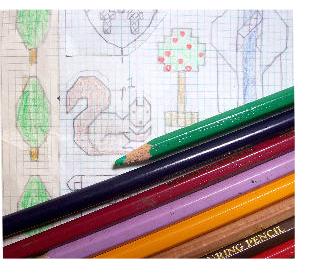
Even though it's called digitalWrite, it will still work with the analog pads on the LilyPad, which is why we can use it with lightStrand1 on the A4 pad.Bead Pattern Design Software, classic and geometrical formats. Since we're using the pads as outputs, we can write the change to them using the digitalWrite function. Setting the LED strand to HIGH turns on the LEDs, and setting it to LOW turns them off. It pauses the loop for 1.5 seconds, turns on one LED strand while turning off the other, pauses for another 1.5 seconds, and reverses the LED strand that's turned on/off to give the alternating effect. The loop function repeatedly runs after the setup function while the LilyPad has power. Initialize Serial, set the baud rate to 9600 bps The value generally used is 9600 as specified here. It helps keep the the flow of data in sync between two devices.
#CROSS STITCH PROGRAMS FOR MAC SERIAL#
The Serial.begin(9600) sets the rate at which serial data is transferred in bits per second (aka, baud). The "pads" on the LilyPad are the same as "pins" on other microcontrollers hence the use of pin in the function name.) (Note: For most microcontrollers, the pads are referred to as pins because they're actually pins connected to the board.
#CROSS STITCH PROGRAMS FOR MAC UPDATE#
This means that pads A4 and 3 will behave as outputs (instead of inputs) so that we can update them in the loop function. The setup function is run once the LilyPad starts the program and sets the pin mode for the two LED strands as outputs. Set which pad each strand of lights is connected to The lines below are variables that set which pads the two LED strands will use. You can copy the sketch for the program from Github. The program for turning the two strands of LEDs on and off is pretty straightforward. Ideally, you should wrap the thread through the terminal multiple times before stitching it into the design to ensure maximum connectivity between the terminal and the thread (I wrapped it three times for each terminal).Ĭross-Stitched Circuit Cross Stitch the Pictureĭuring this step, cross stitch the picture just like you usually would, but honor any pattern changes you'd like to make to accommodate the LEDs added in a future step. Thinking About Sewable CircuitsĮach LED requires at least one stitch of conductive thread on each terminal (positive and negative), so you'll need to leave space for these stitches in the picture. I recommend thinking about the LEDs at the outset and deciding where you want to put them before starting to cross-stitch (although it's ok if you do this after you've sewn the picture). It's helpful to program the LilyPad before you connect the LEDs because it can become awkward to connect it to the computer once it's stitched to the fabric. Lightly brush the fabric glue over the conductive thread once satisfied with the project to protect the thread and keep them in from moving around.Stitch the LEDs into the cross-stitch picture as desired and connect them to the LilyPad.The steps that I followed for completing the project are as follows:

The LilyPad I linked to above from SparkFun worked for me right out of the box. Keep this in mind as you compare and purchase your board. You can add or fix the bootloader, but it's tricky for beginners. With some research, I discovered this tends to happen more frequently with cheaper boards. The bootloader is either missing or broken, though, so I haven't been able to publish programs to it (something I plan to fix at some point). When I started working on this project, I bought a LilyPad from Amazon because it was the cheapest option. If the bootloader doesn't work, you can't put programs onto your board.

However, not all of the LilyPad boards are the same: There are multiple versions of the Arduino LilyPad circuit board, and most of them will work on this project. Fabric glue to secure the conductive thread once you're finished (Amazon affiliate link).Micro USB cable that can transfer data (Amazon affiliate link).Conductive thread (Amazon affiliate link).A non-rechargeable CR2032 battery and battery holder (Amazon affiliate links).A rechargeable Lithium Polymer (LiPo) battery.Battery to power LilyPad, which could be either:.LilyPad LEDs (available in many colors).Cross-stitch fabric and thread (based on your pattern selection).Disclosure: I get commissions for purchases made through links marked as "Amazon affiliate links" in this post. For this project, you'll need the following items.


 0 kommentar(er)
0 kommentar(er)
